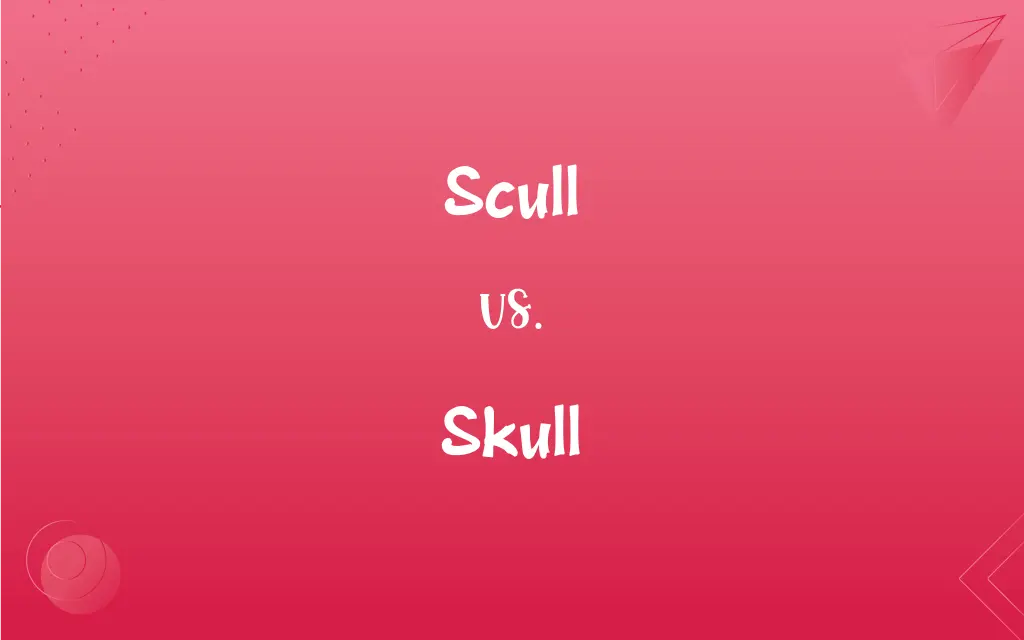Scull vs. Skull: What's the Difference?
By Harlon Moss & Janet White || Updated on March 4, 2024
A scull is a type of oar used for propelling boats, especially in rowing, while a skull is the bony structure forming the head, protecting the brain.

Key Differences
Sculls are long, narrow oars with blades at one end, used in pairs to row a boat. This form of rowing, known as sculling, involves each rower using two oars, one in each hand, to propel the boat forward with a specific technique that maximizes efficiency and speed. Skull, on the other hand, refers to the anatomical structure of the head, comprising several bones fused together to enclose and protect the brain. It also provides attachment points for muscles and supports facial structures, playing a crucial role in the overall function and protection of the head.
While sculls are crafted from materials like wood, carbon fiber, or synthetic composites to achieve lightness and durability for water sports, the skull is a natural, biological structure made up of bone. The design and material of sculls are optimized for performance in competitive rowing and recreational boating. In contrast, the skull's design is the result of evolutionary processes, optimized for protection and support. It includes features like the cranial vault, which houses the brain, and the facial skeleton, which includes the jaws and teeth.
The use of sculls is primarily seen in the sport of rowing, where technique, strength, and endurance are key to effective sculling. This sport can be both individual and team-based, with events ranging from single sculls to larger boats where teamwork and coordination are essential. The skull, whereas, is a fundamental part of human and animal anatomy, studied in fields like medicine, anthropology, and biology. Its study helps in understanding not only human evolution but also in medical diagnostics and forensic science, where the skull's features can be used to determine identity, cause of death, and historical context.
Comparison Chart
Definition
A type of oar used for propelling boats.
The bony structure forming the head.
Use
In rowing, for propulsion.
Encloses and protects the brain.
ADVERTISEMENT
Composition
Made of wood, carbon fiber, or composites.
Composed of bone.
Field
Sports, especially rowing.
Medicine, anthropology, biology.
Characteristics
Long and narrow with blades.
Consists of cranial and facial bones.
Scull and Skull Definitions
Scull
Equipment in rowing for moving boats.
The team stored their sculls carefully after practice.
Skull
Encases the brain and supports facial features.
The anatomy class studied the structure of the human skull.
ADVERTISEMENT
Scull
A narrow oar for rowing, used in pairs.
He adjusted his grip on the sculls, preparing for the race.
Skull
Comprised of several fused bones.
The forensic team examined the skull for signs of injury.
Scull
Part of the sport of sculling.
Their sculls cut through the water smoothly, propelling them forward.
Skull
Studied in medicine and anthropology.
The ancient skulls provided clues to the early human diet.
Scull
Used by rowers in both hands.
With sculls in hand, he moved in perfect harmony with the water.
Skull
The bony or cartilaginous framework that encloses and protects the brain and sense organs of all vertebrates and of one group of nonvertebrates (the hagfishes); cranium.
Scull
A long oar used at the stern of a boat and moved from side to side to propel the boat forward.
Skull
(Informal)The head, regarded as the seat of thought or intelligence
Use your skull and solve the problem.
Scull
One of a pair of light oars designed for use by a single rower.
Skull
(anatomy) The main bones of the head considered as a unit; including the cranium, facial bones, and mandible.
Scull
A small light racing boat for one, two, or four rowers, each using a pair of sculls.
Skull
(figuratively) The mind or brain.
Scull
To propel (a boat) with a scull or a pair of sculls.
Skull
A crust formed on the ladle, etc. by the partial cooling of molten metal.
Scull
To use a scull or a pair of sculls to propel a boat.
Skull
The crown of the headpiece in armour.
Scull
To generate propulsion, as in swimming, with a motion resembling that of a single scull oar.
Skull
(Scotland) A shallow bow-handled basket.
Scull
A single oar mounted at the stern of a boat and moved from side to side to propel the boat forward.
Skull
Obsolete form of school
Scull
One of a pair of oars handled by a single rower.
Skull
To hit in the head with a fist, a weapon, or a thrown object.
Scull
A small rowing boat, for one person.
Skull
To strike the top of (the ball).
Scull
A light rowing boat used for racing by one, two, or four rowers, each operating two oars (sculls), one in each hand.
Skull
A school, company, or shoal.
A knavish skull of boys and girls did pelt at him.
These fishes enter in great flotes and skulls.
Scull
Obsolete form of skull
Skull
The skeleton of the head of a vertebrate animal, including the brain case, or cranium, and the bones and cartilages of the face and mouth. See Illusts. of Carnivora, of Facial angles under Facial, and of Skeleton, in Appendix.
Scull
A skull cap. A small bowl-shaped helmet, without visor or bever.
Skull
The head or brain; the seat of intelligence; mind.
Skulls that can not teach, and will not learn.
Scull
(obsolete) A shoal of fish.
Skull
A covering for the head; a skullcap.
Let me put on my skull first.
Scull
The skua gull.
Skull
The bony skeleton of the head of vertebrates
Scull
To row a boat using a scull or sculls.
Skull
The bone structure of the head.
The x-ray showed a fracture in the skull.
Scull
To skate while keeping both feet in contact with the ground or ice.
Skull
Essential for protecting the brain.
Her helmet saved her skull from injury during the fall.
Scull
To drink the entire contents of (a drinking vessel) without pausing.
Scull
The skull.
Scull
A shoal of fish.
Scull
A boat; a cockboat. See Sculler.
Scull
The common skua gull.
Scull
To impel (a boat) with a pair of sculls, or with a single scull or oar worked over the stern obliquely from side to side.
Scull
To impel a boat with a scull or sculls.
Scull
A long-handled oar mounted at the stern of a boat and moved left and right to propel the boat forward
Scull
One of a pair of short-handled oars
Scull
A racing shell propelled by one or two oarsmen pulling two oars
Scull
Propel with sculls;
Scull the boat
Scull
A tool in competitive and recreational rowing.
She chose the lightweight carbon fiber sculls for the competition.
FAQs
What materials are sculls made from?
Sculls are made from materials like wood, carbon fiber, and synthetic composites for lightweight and durability.
What is a skull?
A skull is the bone structure that forms the head, protecting the brain and supporting facial features.
How do sculls and skulls differ in use?
Sculls are used in rowing for boat propulsion, while skulls are part of the skeletal system, protecting the brain.
How are skulls studied?
Skulls are studied in fields like medicine, anthropology, and biology for insights into health, evolution, and identification.
What does the skull consist of?
The skull consists of several bones that are fused together, including the cranial and facial bones.
What evolutionary purpose does the skull serve?
The skull evolved primarily to protect the brain and support sensory organs, crucial for survival.
What sports involve sculls?
The sport of rowing, including sculling, involves the use of sculls.
Are sculls used in solo or team rowing?
Sculls are used in both solo and team rowing disciplines, from single sculls to larger boats.
Why are sculls designed to be lightweight?
Lightweight sculls improve rowing efficiency and speed, essential for competitive and recreational rowing.
What is a scull?
A scull is a type of oar used in pairs for rowing boats, characterized by its long and narrow design.
Can anyone use a scull?
Yes, with proper training, anyone can learn to use sculls for rowing.
Are all skulls the same?
While the basic structure is similar, the shape and size of skulls can vary greatly among individuals and species.
Do sculls require maintenance?
Yes, sculls require regular maintenance to ensure they remain in good condition for rowing.
Is the skull considered a single bone?
No, the skull is made up of multiple bones that are fused together.
How do rowers hold sculls?
Rowers hold one scull in each hand, using a specific grip and technique for effective propulsion.
Can the design of sculls vary?
Yes, the design of sculls can vary to suit different rowing styles and boat types.
How does the skull's structure protect the brain?
The skull's hard, bony structure absorbs and distributes impact forces, protecting the brain from injury.
Why are sculls important in rowing?
Sculls are essential for propelling and steering the boat, fundamental to the sport of rowing.
What can skulls tell us about ancient humans?
Skulls can provide insights into the health, diet, and evolutionary history of ancient human populations.
What are the key features of a skull?
Key features include the cranial vault, facial skeleton, and openings for sensory organs.
About Author
Written by
Harlon MossHarlon is a seasoned quality moderator and accomplished content writer for Difference Wiki. An alumnus of the prestigious University of California, he earned his degree in Computer Science. Leveraging his academic background, Harlon brings a meticulous and informed perspective to his work, ensuring content accuracy and excellence.
Co-written by
Janet WhiteJanet White has been an esteemed writer and blogger for Difference Wiki. Holding a Master's degree in Science and Medical Journalism from the prestigious Boston University, she has consistently demonstrated her expertise and passion for her field. When she's not immersed in her work, Janet relishes her time exercising, delving into a good book, and cherishing moments with friends and family.































































